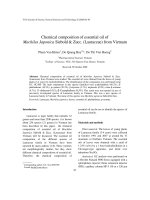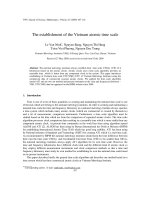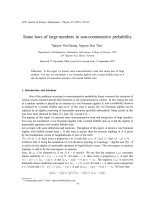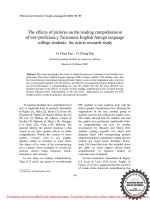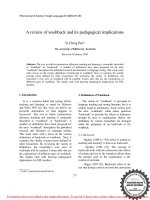Báo cáo " Congestion control of Wavelet image compression over wireless networks " docx
Bạn đang xem bản rút gọn của tài liệu. Xem và tải ngay bản đầy đủ của tài liệu tại đây (120.43 KB, 8 trang )
VNU Journal of Science, Mathematics - Physics 23 (2007) 55-62
55
Congestion control of Wavelet image compression
over wireless networks
Ho Anh Tuy
1
,
Nguyen Vinh An
2,*
1
Hanoi University of Technology, 1 Dai Co Viet, Hai Ba Trung, Hanoi, Vietnam
2
Hanoi Open University, Building B101 Back Khoa, Hai Ba Trung, Hanoi, Vietnam
Received 6 April 2007
Abstract. The demand of transmission of images and video is increasing quickly recently and
researchers are trying to invest good solutions to improve the quality of these over wireless
networks. There are still challenges due to the different characteristics and quality of images
between wired and wireless channels. An important issue is congestion control to ensure network
stability and achieve a reasonably fair distribution of the network resources among the users. The
paper will present a model of congestion control by combining Wavelet image compression at the
source with applying Fuzzy logic technique to control traffics. The simulation shows a good result,
the transmission rate can be adjusted to adapt the changes of wireless channel, the buffer of
intermediate devices will not be swung from idle to overflow or vice versa so that the cell loss rate
is small.
1. Introduction
For transmission of image over wireless channels, it is important to have a robust system when the
channel conditions vary as a function of time. Traditional systems use a DCT transform for image
compression and then matched to the bit rate for which the channel code is designed. DCT is one of
the most popular technologies for image processing, including JPEG standard, MPEG standards,
H.261, ect. There are some problems with this system. Firstly, the system breaks down very fast if the
SNR falls below the design level. Secondly, DCT will cause the “blockness artifact” when the
compressing ratio over 50:1. Thirdly, the image services are limited by the poor quality and low
compression ratio. Lastly, the systems are much suffered by varying of the bit rate over channel.
Wavelet transform has recently been used to replace DCT in many coding systems. The
advantages of Wavelet are high compression ratio, avoiding “blockness artifact” and better quality.
The multiresolution of Wavelet is very meaningful characteristic for transmission of image over
wireless network [1].
Low bit rate, the fading and fast time varying are main drawbacks for transmission of images over
wireless channels. Congestion can be occurred at the nodes because the number of incoming packets
are unpredictable. Congestion control is an important network element. The purpose of congestion
control is to ensure network stability and achieve a reasonable distribution of the network resources
among the users.
_______
*
Corresponding author. Tel: 84-4-8680909.
E-mail:
Ho Anh Tuy, Nguyen Vinh An / VNU Journal of Science, Mathematics - Physics 23 (2007) 55-62
56
TCP is a well-established protocol, which offers reliable transportation of data. The increased
demand in using of the Internet lead to the need of designing and applying of effective congestion
control algorithms. Many active queue management schemes have been proposed to provide high
network utilization with low loss and low delay in TCP/IP networks. Random Early Detection (RED),
Explicit Congestion Notification (ECN), TCP Sliding Window, Slow Start are commonly used in
wired networks. In these schemes, the discarded policy of arriving packets is based on overflow of the
buffer in nodes [2].
In this paper, we use fuzzy logic techniques to develop a new queue management scheme in hop
by hop wireless networks. The application of fuzzy control in networks is suitable due to the
difficulties in obtaining a precise mathematical model while intutive understanding of congestion
control is available. A fuzzy engine is designed to operate on buffer queues and use linguistic rules to
control the transmission rate in wireless network.
The paper is organized as follows: Section II discusses the Wavelet image compression. In section
III, we briefly review some properties of fuzzy logic controller and present our congestion control
scheme. Section IV presents simulation result and discuss the possible of applying fuzzy logic in
telecommunication.
2. Wavelet Image compression
2.1. What are wavelets
Today, most of the research and development which related to transform signal has been involving
the Fourier transform. The Fourier transform uses infinite-duration sinusoids as the basic function for
the transform, the short-time Fourier transform (FFT) use truncated or windowed sinusoids. The input
signal is observed only in frequency domain, we don’t know when and where they are occurred.
Wavelet transform is linear and square integrable transforms having a mother waveform. There are
many types of wavelets, which can be smooth or compactly supported. Once the type of mother
wavelet is established, daughter wavelets are formed by shifting and scaling, these form a complete
orthonormal set. If we define
ψ
(t)
as the mother waveform, a complete orthogonal set of daughter
wavelets
,
( )
a b
t
ψ
can be generated from
ψ
(t)
by dilation (by a factor of a) and shift (by amount b)
1
ψ ψ
a,b
t b
(t)
a a
−
=
(1)
Parameter
a
defines the length of the window time and
b
is its location. Short, high frequency
wavelets can give more time information and less frequency information. Low, long frequency
wavelets are used to obtain more frequency information and limited time information.
To analyse data at different resolutions, a scaling function
w(t)
is used in conjunction with the
mother wavelet
2
1
1 ψ 2
N
k
k
k
W(t) ( ) C ( t k)
=
=−
= − +
∑
(2)
In equation,
C
k
are the wavelet coefficients which satisfy the constraints
1
0
2
N
k
k
C
−
=
=
∑
and
1
0
0
2
δ
N
k b b.
k
C C
−
=
=
∑
(3)
Ho Anh Tuy, Nguyen Vinh An / VNU Journal of Science, Mathematics - Physics 23 (2007) 55-62
57
In this case,
δ
is the delta function and
b
is the location index. This allows for the defining
coefficients to be varied according to the wavelet system to be used [3].
2.2. Comparing between DCT and Wavelet-based Image coding
Wavelet compression offers two main advantages over DCT:
•
Improved scalability - This is because the wavelet transform process can be repeated for as
many iterations as needed. At the decoder, decoding can stop any time if entire resolution
of the original image is not required. This would depend on the resolution of the display
device being used.
•
Higher efficiency at low bit rates – The fewer wavelet coefficients can be quantized
compare with DCT.
However, hardware and software using DCT is much simpler than that using wavelet. This would be
an important factor to consider if mobile hand held devices with limited battery capacity being used.
2.3. The tree structure and subband coding
In practical, wavelet transform is referred to as subband coding using tree structure. This takes
place in the following way:
a.
The image is filtered horizontally by convolving it with the high pass filter, that extracts
high spatial frequency and high details.
b.
The image is seperately convolved horizontally with a complementary low-pass filter to
get low frequencies.
c.
The results in two sub-image that contain high and low horizontal frequencies can be
convolved with each of the separately vertical filters to obtain four sub-image. This
process is illustrated in figure 1
d.
This process is repeated for the sub-image block containing low horizontal and low
vertical frequencies (LL) to obtain higher band decomposition filter tree.
Image
Horizontal
Wavelet
Horizontal
Scaling
Funct ion
Vertical
Wavelet
Vert ical
Scaling
Funct ion
Vertical
Wavelet
Vert ical
Scaling
Funct ion
All frequencies
High Horizontal
Frequencies
All Vertical
Frequencies
Low Horizotal
Frequencies
All Vertical
Frequencies
HH
HL
LH
LL
High Horizontal
Frequencies
High Vertical
Frequencies
Low Vertical
Frequencies
High Horizontal
Frequencies
Low Vertical
Frequencies
Low Horizontal
Frequencies
Low Horizontal Frequencies
High Vertical Frequencies
Figure 1. Dividing image into four sub-image [4].
Ho Anh Tuy, Nguyen Vinh An / VNU Journal of Science, Mathematics - Physics 23 (2007) 55-62
58
The forward wavelet transform describes the pixel values of the original image and the result is a
small number of coefficients. The compression can be obtained by quantizing the non-zero wavelet
coefficients and further compression ratio can be got by Huffman coding.
3. Congestion control using Fuzzy Logic
3.1. Fuzzy logic
Fuzzy logic is one of the tools commonly known as Computational Intelligence. Fuzzy logic
control may be viewed as a way of designing feedback controllers in situations where rigorous control
theoretic approaches can not be used. The control algorithm is encapsulated as a set of linguistic rules.
Fuzzy logic controller has been successful for controlling system possibly too complex and highly
nonlinear. In recent years, a number of research papers using fuzzy logic to invest congestion control
of ATM networks have been published. A survey is given in [5].
3.2. Fuzzy logic implementation
A wireless networks is a large distributed complex system with difficulty of highly non-linear,
time varying and chaotic behavior. Dynamic or static modelling of such a system for control is
extremely complex. Measurements on the state of the network are incompleted, often poor and time
delayed. In order to enable wireless image and multimedia communication, the bottlenecks to
communicating image data over wireless must be addressed.
Network congestion control remains a critical issue and high priority, especially in growing size,
low speed (bandwidth) of the increasingly integrated networks. Current solutions in existing networks
are becoming ineffective and can not easily scale up. The approach to congestion control for
traditional TCP/IP and ATM are proceeded separately [6]. Fuzzy logic controllers may be viewed as
an alternative, non-conventional way of designing feedback controllers . It is a convenient and
effective way to build a control algorithm without relying on formal models of the controlled system
and control theoretic tools. The control algorithm is encapsulated as a set of commonsense rules.
Fuzzy logic control has been applied successfully to the task of controlling systems for which
analytical models are not easily obtainable or the too complex and highly nonlinear model. In this
paper, we propose a rate control scheme using fuzzy logic, which is applied in hop by hop wireless
networks.
3.3. Fuzzy control algorithm
Our model of fuzzy control system is based on a queue management scheme to provide
transmission rate control in hop by hop wireless networks. The system model is shown in Figure 2.
The cell rate of data sources are adjusted by feedback information carried by source management
cells. Source management cells are generated by sources, transmitted towards the destination end
system hop by hop. The next node will send back these cells to the current node. The feed back cells
will examine the state of buffer in next node, and tell the previous how to change Explicit Rate. The
data source, upon receiving feedback cells will adjusts it’s rate more or less.
In scheme, both current queue length and its growth rate are monitored. The queue length look at the
current state of the buffer and the growth rate provides some knowledge’s of prediction for the near
future of buffer behavior. So the scheme will be more effective than existing schemes they only based on
the queue length threshold. The block diagram of fuzzy controller system is illustrated in figure 3.
Ho Anh Tuy, Nguyen Vinh An / VNU Journal of Science, Mathematics - Physics 23 (2007) 55-62
59
Wavelet
image
source
Processing
Buffer
Discarded Cell based on Buffer overflow
Next hop
Feedback
Figure 2. The source channel rate control using fuzzy logic.
Compare
Fuzzifier
Inference
engine
Defuzzifier
Select ed
quantization
Level
Membership
functions
Rule base
Buffer threshold
Current buffer length
Queue grow rate
Rate controlling
Queue
Length
Error
Figure 3. Block diagram of fuzzy control system.
3.4. Rule base design
The design of a rule base [6] includes two parts: First, the linguistic rules are set (table 1) and
afterwards, membership functions of the linguistic values are determined (figure 3).
We define INPUT and OUTPUT variables as:
INPUT #1
: Number of packets loss %
•
Small - when number of packet’s losses is less than 0.4% (S)
•
Acceptable - when number of packet’s losses is 0.4-0.7% (A)
•
High - when number of packet losses is greater than 0.7% (H).
INPUT#2:
Buffer grow length
•
Decrease Fast (-F).
Ho Anh Tuy, Nguyen Vinh An / VNU Journal of Science, Mathematics - Physics 23 (2007) 55-62
60
•
Decrease Slow (-S).
•
Not change (NC).
•
Increase slow (+S).
•
Increase Fast (+F).
OUTPUT:
Transmission rate is in range 0 - 300 Kbps.
Table 1. Fuzzy Rule Matrix.
Queue Length Rate
-F -S NC +S +F
H
300 250 120 75 25
A
300 250 200 100 25
Packet loss %
S
300 300 250 125 75
In table 1 shows the fuzzy conditional rules for the model. Rules in table 1 can be interpreted as:
IF
queue length is too short and queue is decreasing fast
THEN
flow rate is 300 kbps
IF
queue length is too short and queue is decreasing slowly
THEN
flow rate is 300 kbps
IF
queue length is too short and queue is not changing
THEN flow rate is
250 kbps
IF
queue length is too short and queue is increasing fast
THEN
flow rate is 75 kbps
IF
queue length is too short and queue is increasing slowly
THEN
flow rate is 125kbps
IF
queue length is acceptable and queue is decreasing fast
THEN
flow rate is 300 kbps
IF
queue length is acceptable and queue is decreasing slowly
THEN
flow rate is 250 kbps
IF
queue length is acceptable and queue is not changing
THEN
flow rate is 200 kbps
IF
queue length is acceptable and queue is increasing slowly
THEN
flow rate is 100 kbps
IF
queue length is acceptable and queue is increasing fast
THEN
flow rate is 25 kbps
IF
queue length is too high and queue is decreasing fast
THEN
flow rate is 300 kbps
IF
queue length is too high and queue is decreasing slowly
THEN
flow rate is 250 kbps
IF
queue length is too high and queue is not changing
THEN
flow rate is 120 kbps
IF
queue length is too high and queue is increasing slowly
THEN
flow rate is 75 kbps
IF
queue length is too high and queue is increasing fast
THEN
flow rate is 25 kbps
3.5. Membership functions
Membership functions are shown in figure 4
Ho Anh Tuy, Nguyen Vinh An / VNU Journal of Science, Mathematics - Physics 23 (2007) 55-62
61
1
0
10.4 0.7
0.5
NC
S H
0 10050 653515 85
- F
- S NC + S + F
1
Small High
Acceptable
Number of packet's losses (%)
Decreasing Fast
Decreasing Slowly
NOT CHANGE
Increasing slowly
Increasing Fast
Length of Buffer (%)
Figure 4. Membership functions for input variables.
3.6 Simulation results
A Matlab program has been developed to simulate the behavior of the fuzzy model. The results are
illustrated in figure 5. The x axis represents the cell loss at the buffer and the y axis represents how
transmission rate from the source could be. We can see that at one value of cell loss in buffer, one out
of five transmission rates could be selected, the rate depends on how growing rate in buffer is.
Figure 5. Adjusting the transmission rate of source using Fuzzy logic.
Ho Anh Tuy, Nguyen Vinh An / VNU Journal of Science, Mathematics - Physics 23 (2007) 55-62
62
4. Conclusion
Applying Wavelet for image compression can improve the compression ratio, the quality of
reproducing image. Using Wavelet image compression, the scalable and progressive image
transmission can outperform than other methods. When too many compressed image sources send too
much data simultaneously, the network will difficulty to handle. Consequently, network congestion
had occurred which causes lost of packets and long delays. In order to control this problem, one
method of adjusting transmission rate to avoid buffer overflow at routers using fuzzy logic is
presented in the paper. The results show that the transmission rate of the source can be flexible to
adapt with the channel capacity. The buffer will not be swung from idle to overflow or vice versa. We
can see that fuzzy logic controller can be used not only to control congestion, but also to adjust many
other network parameters.
References
[1] Clark N. Taylor, Sujit Dey, “Adative Image Compression for Wireless Multimedia Communication”, Electrical and
Computer Engineering, University of California, San Diego, La Jolla, California, USA.
[2] A Pitsillides, Y.A, Sekercioglu, G. Ramamurthy, “Effective control of traffic flow in ATM networks using fuzzy
explicit rate marking (FERM)”, IEEE Journal 15 (1997) 209.
[3] O. Rioul, M. Vetterli, “Wavelets and signal processing”, IEEE Signal Processing Magazine 1991.
[4] M. Antonini, M. Barlaud, P. Mathieu, I. Daubechies, “Image coding using wavelet transform,” IEEE Trans. Image
Process 1 (1992) 205.
[5] A Sekereioglu, A Pitsillides, A Vasiliakos, “Computational intelligence in management of ATM networks”, Soft
Computing Journal 5 (2001) 257.
[6] C. Lee, “Fuzzy logic in control systems: Fuzzy logic controller”, IEEE Trans. Systems 20 (1990) 404.
